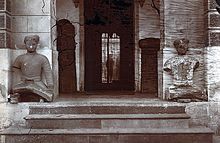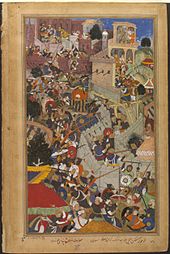Jaimal Rathore (1507–1568) was the Rathore (Mertiya) ruler of Merta. He was cousin of the Hindu saint Mirabai[1] and Great grandson of Rao Jodha Rathore and Grandson of Rao Duda Rathore (Founder of Mertiya clan of Rathore's & Established Merta). He became the ruler of Merta after the death of his father, Rao Veeram Dev. His father was perceived as the strongest king of the east in his time.[1] The Amar Kavya records that Udai Singh II granted Badnor along with 210 villages to Rao Jaimal.[2] In 1553, Jaimal resisted falling under the chakri (service relationship) of Maldeo of Marwar.[3]
| Jaimal Rathore | |
|---|---|
| Ruler of Merta | |
| Reign | 1540s-1562 |
| Predecessor | Rao Veeram Dev |
| Successor | Rao Surtan & Rao Keshavdas |
| Born | 17 September 1507 |
| Died | 22 February 1568; in Chittorgarh |
| Religion | Hinduism |


The Siege of Chittorgarh
editIn 1567, when Akbar encamped outside Chittorgarh, in hopes of conquering the fortress, the ruler of Mewar, Udai Singh II, fled to the Aravali hills alongside his family, and left the fortress in charge of 8,000 soldiers and 1,000 musketeers, who were in command of Jaimal and Patta. Jaimal died in Chittorgarh on 22 February 1568 by a musket shot fired by Akbar himself.[4] This turned the tide of battle in the Siege of Chittorgarh and the Rajputs' morale decreased.[5] Jaimal's name is commonly mentioned with his partner leader of chittor, Patta. These two were given the command of the army when Udai Singh, along with the royal family, had to leave the fort and go to the hills. Their attempts to repulse the Mughal Emperor himself was such that Akbar himself ordered the construction of their statues outside his fort in Agra to honour their courage.
"At this time H.M.(Akbar) perceived that a person clothed in a cuirass known as the hazār mīkhī (thousand nails) which is a mark of chieftainship among them, came to the breach and superintended the proceedings. It was not known who he was. H.M. took his gun Sangrām, which is one of the special guns, and aimed it at him..... And in fact on the morning when the breeze of victory and dominion arose, it was ascertained that the Shāhinshāh's musket had reached Jaimal, the governor of the fort, and had at once destroyed both him and the fort." ~ The death of Jaimal, Akbarnama by Abu'l Fazl[6]
One of his son, Ramdas Rathore went on to fight against the Mughals in the Battle of Haldighati, where he was slain and killed by Jagannath Kachhwa of Amer.[7]
In popular culture
edit- 2013-2015: Bharat Ka Veer Putra – Maharana Pratap, broadcast by Sony, Jaimal was portrayed by Ved Thappar.[8]
References
edit- ^ a b Sharma, Ambika Prasad (2001). Language of Love. Sarup & Sons. p. 54. ISBN 9788176252461.
- ^ G. D. Sharma (1977). "Some Aspects of the Mewar Polity at the Time of Maharana Pratap's Accession". Proceedings of the Indian History Congress. 38. Indian History Congress: 263. JSTOR 44139080.
- ^ Tanuja Kothiyal (2016). Nomadic Narratives: A History of Mobility and Identity in the Great Indian Desert. Cambridge University Press. p. 91. ISBN 9781107080317.
- ^ "Akbarnama by Abu'l Fazl". Archived from the original on 14 August 2017. Retrieved 1 January 2018.
- ^ Relia, Anil; Parimoo, Ratan (18 November 2014). The Indian Portrait - 5: Colonial influence on Raja Ravi Varma and his Contemporaries. Archer Art Gallery. p. 82. GGKEY:CKAH1ERUGDU.
- ^ "Archived copy". Archived from the original on 14 August 2017. Retrieved 1 January 2018.
{{cite web}}: CS1 maint: archived copy as title (link) - ^ < Akbarnama by Abu'l Fazl "Rām Dās, son of Jaimal, went to the sorry abode of annihilation from a stroke by the hand of Jagannāth."
- ^ "Remember 'Raja Aur Rancho'? Here's what our favourite detective Raja is up to now - Times of India". The Times of India. 30 May 2016. Retrieved 17 April 2022.